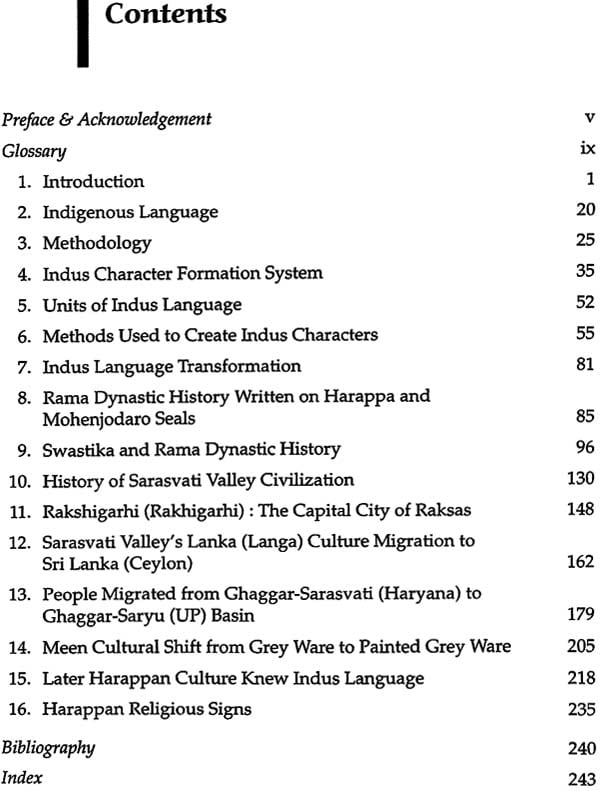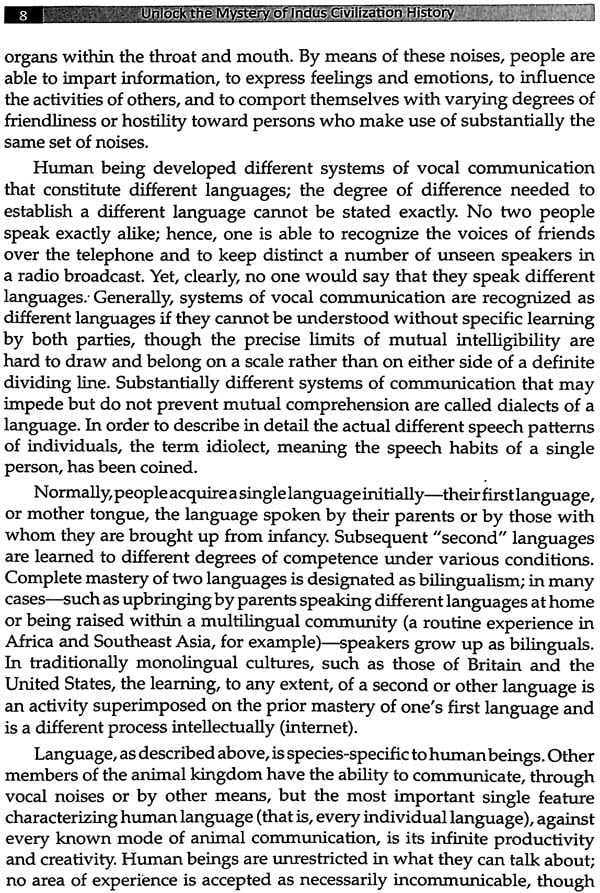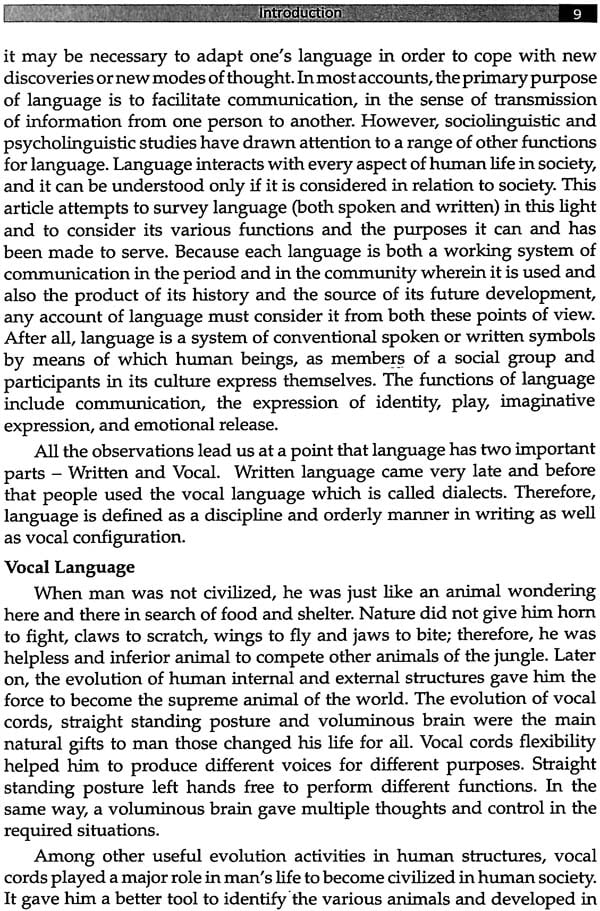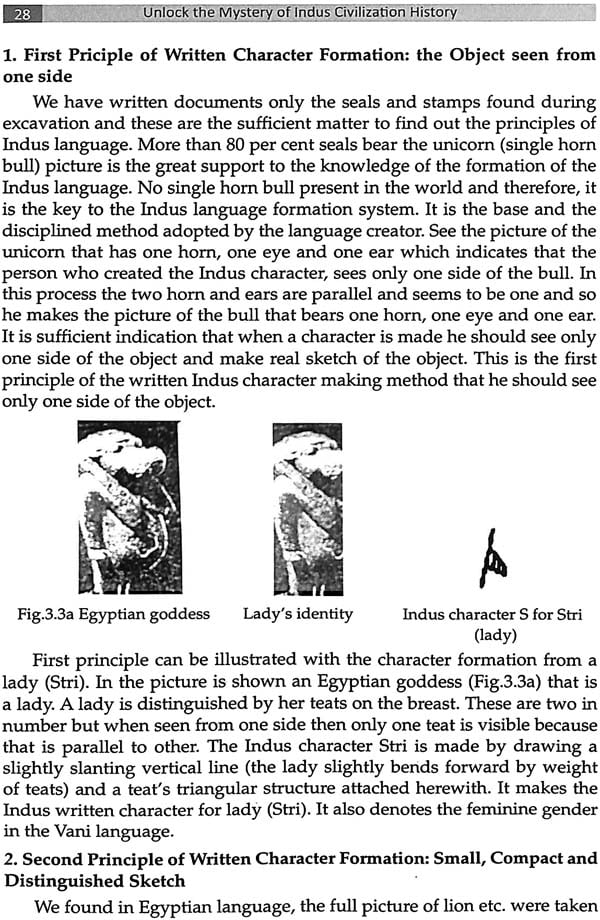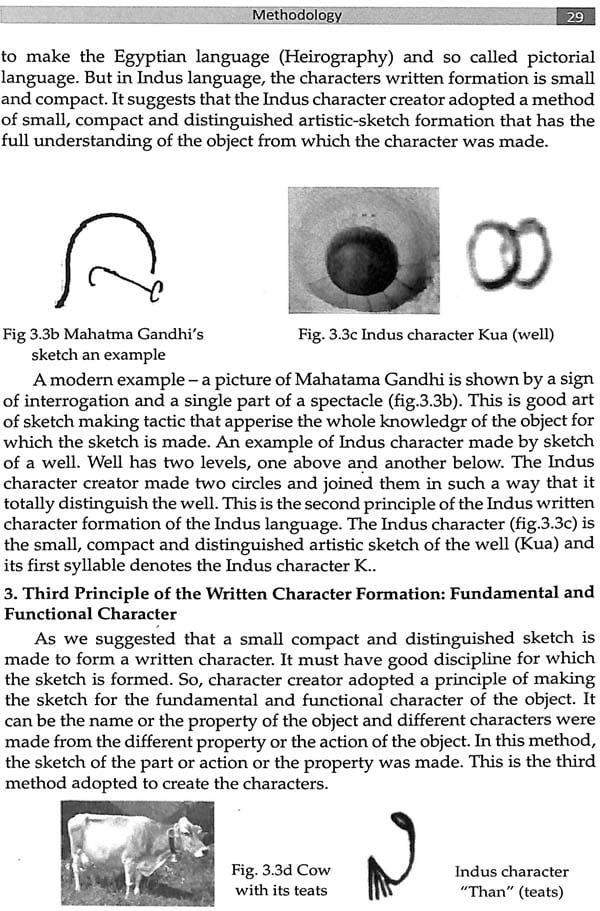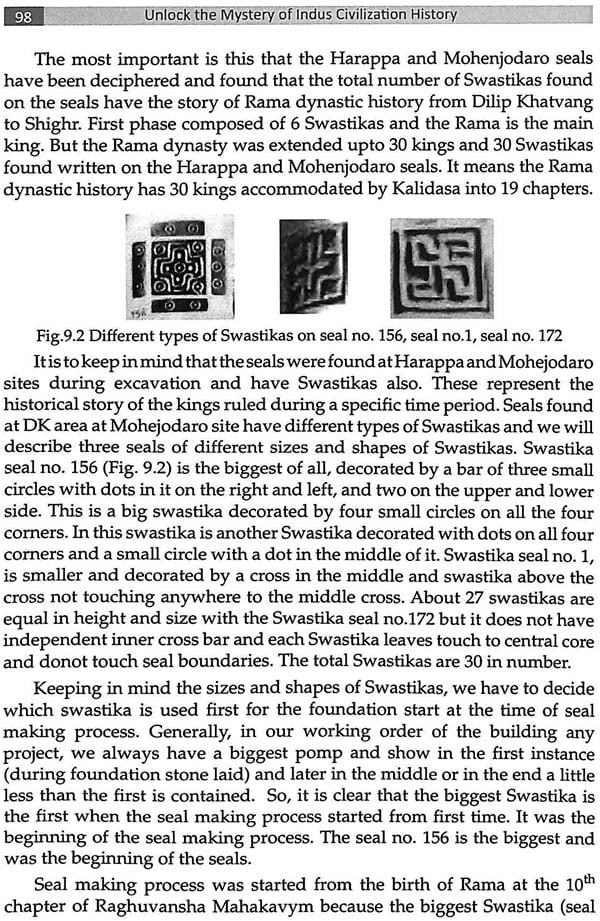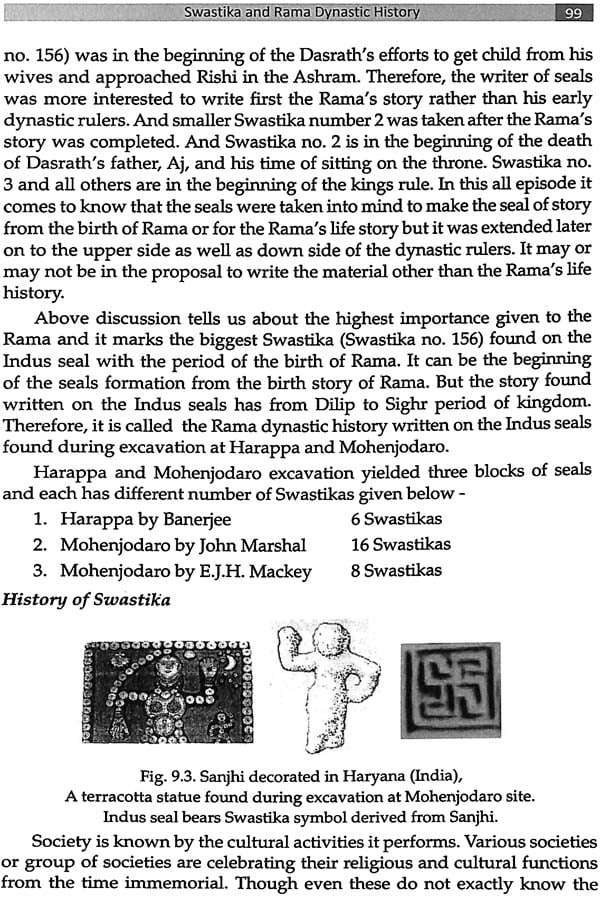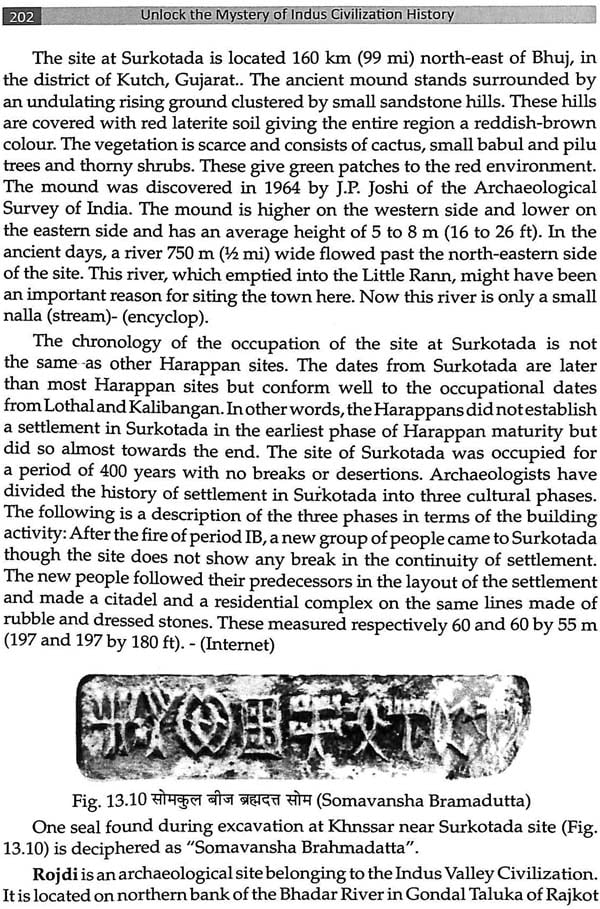
Unlock the Mystery of Indus Civilization History Decipherment of Indus Script
Book Specification
| Item Code: | NAO799 |
| Author: | Dhanpat Singh Dhania |
| Publisher: | Kaveri Books |
| Language: | English |
| Edition: | 2019 |
| ISBN: | 9789386463104 |
| Pages: | 258 (Through out B/W Illustrations) |
| Cover: | HARDCOVER |
| Other Details | 10.00 X 7.50 inch |
| Weight | 800 gm |
Book Description
This book describes two important factors — the decipherment of Indus language and Indus valley civilization history and culture identification. It discusses about the Indus language formation system, its natural and regional properties, Indus seals written order and method of writing and reading, Indus language methodology, its various principles of character formation system, its units and methods adopted to create the Indus language characters. Further it explains about the transformation of Indus language into various languages i.e. Sanskrit, Brahmi etc. It contains the decipherment of Indus seals and Rama dynastic history found written on Harappa and Mohenjodaro seals. Harappan People's migration from Ghaggar-Sarasvati (Haryana) to Ghaggar-Saryu (UP) Basin has also been described. It explains about the Meen dynastic cultural people shifted from Grey Ware to Painted Grey Ware. An engraved slab found at Bhaja rockshelter (Pune hills) written in Brahmi and Indus languages, that calibrated as 200 BCE accords the later period of Indus language use. The razor found during excavation at Rodji and written language over it was deciphered as Kaal Bhairo. A slab found at Harappa deciphered as Chandi Maa, Vishnu statue at Naushero, Khappar Bharni statue at Mohenjodaro, Shiv-Linga at Kalibangan, all accords the worship of the cult of Indus valley civilization.
It is hoped that this well illustrated book will help the reader to discover and unlock the mystery of Indus history and culture.
Dhanpat Singh Dhania (b. 1954) got his high school education from village school, passed BA from Delhi University and pursued for post graduation from H.P. University (1981), Kurukshetra University (2000) and IGNOU (2012). After graduation, he deeply involved in the study of Indus civilization language decipherment. During Indus civilization study period, he studied Brahmi, Egyptian, Cretan, Mesopotamian etc. languages. He was the author of several books published i.e. Harappan Mystery Deciphered (2003), Indus Valley Civilization (2005), Deciphering Indus Script: A New Approach (2008), Ancient Indus History and Culture; Mehra Dynasty (8000 BC): The Founding Father of Indus Valley Civilization (2014). He attended many national and international seminars and presented papers. He presented his research findings on televisions, newspapers and magazines published his articles. Presently he is doing research on the relation of Ubedian culture to Aryans.
It was the year 1973, when I was sitting by the side of a primary school going boy and he read from the book (in which chapter the Indus bull picture was seen) that Indus language still remained undeciphered. It stroked me a lot that the man has gone to the moon and attained the heights of education and research but unable to decipher even a language. After that, every news about Indus language increased the curiosity to get more of it. No school or university books have the study about the Indus language. After all, one day, I got opportunity to sit in the National Museum library. It was the turning point when I read the Irathavan Mahadevan's book named 'The Indus Script'. This is a bulky book that has concordance in serial order and has photocopies of many Harappan seals. I saw the seal's pictures and the language on it. The primary attention goes towards Brahrni script because the Brahmi script has this type of characters. I found out the sources of Brahmi script on Ashoka's pillars' language and started learning the language. I noted the alphabetically order of Brahrni script. But when I started composing the Indus seals in the order of Brahmi script, in the hit-and-trial method (chemistry method of the molecules should be equal before and after reaction), I totally failed. All the similar types of characters did not consonant in the same order.
After that, I tried to learn the Mesopotamian and Egyptian languages. I also tried and found that many Indus script characters were found in many ancient languages i.e. Egyptian, Cretan, English, Russian, Iyo, Meritsune etc. It was not right that Indus language characters were the outcome of these languages but it was certain that it was based on natural characters found all over the world. It made me aware that all the written signs did not have the same phonetic value in all the languages. Each language has its own phonetic value and that was in accordance to their regional people's psychology and behaviour towards the surrounding environment. Therefore, now, the whole world has become a laboratory for me and each man and his activities were the source of language formation tools. Every time I wanted to know the fundamental and functional characters of the things and tried to find out the people attitude and nomenclature for that purpose. It was a limit because what I found was the present time psychology and behaviour of the people. But to know about the Harappan period's people and its environment, we must penetrate the layers of civilizations those come in between today and that period. We have to surpass today and go to the Harappan period to know the exact position of the people and its surroundings. Luckily I was born in the Harappan civilization village in that period when no industrialization took place. There was no tractor to cultivate the fields and a small land was to cultivate by bullocks and jungle all around the village. People had limited resource and the same process of agriculture as was in the Harappan period. The human psychology and behaviour was in the same formation as was in Harappan period. I, in my childhood, lived in the old form of society and obsolete working conditions. Therefore, I could understand the ground situation and was in a position to estimate the man and environment. This situation encouraged me to find out the real Indus language formation system.
When no book knowledge succeeded to find out the exact position of the Indus language, I took camera and went to the fields to find out the natural phenomena. First of all, I went to the jungle because this was in the same position from immemorial period. From a suitable distance, I took its photograph. After that, I went inside it and found a hut which was made by cutting the trees. The trees were lying by the side of the but reminded me that the but was made after removing the jungle trees. It was great occasion when I thought that the dwelling (Basti) was possible only by removing the jungle. It struck me and it might have struck to the Harappan-language-creator who created characters of language from Jungle and Basti. I came home and found out the definition of jungle (Van). The dictionary describes that the jungle is defined as the place full of unlimited trees and live unlimited wild animals. I understand that jungle has two most important characters, i.e. Trees and Animals. Now, one thing was clear that the jungle is called 'Vn' in Indus language and this was the vocal or the phonetic value part. We have to find out only the written part of the Vn. This was an artistic approach to make the written character. First of all, I erected a line to mark a tree but the jungle has unlimited trees and I cannot erect unlimited lines. So, I thought about the animals and erected four lines to depict four legs of the animal. We get four lines with a base but we have to show unlimited trees and unlimited animals, therefore, I add one more parallel line to the base to mark it more figures (as image of parallel object sees in between the parallel mirrors). It was great joy when I matched it with the double sided seal found during excavation at Mohenjodaro, and it matched perfectly with the lion (the van) bearing seal and Basti (domestic goat bearing picture) bearing seal. It was the first fruit of hard work and a success in right direction. After that, I created many characters based on the natural phenomina.
However, it was not the end but it opened the way to achieve the goal. I deciphered the signboard found during excavation by R.S. Bisht in 1889 as 'Chkradhar Chkravati Chkrin' and it was proved historically that the king Chkradhar ruled in western Gujarat in the ancient period. After that I devoted full time to the research work and about thirty years of hard work now I am fully satisfied that I have deciphered the Indus language fully.
The Indian Archaeological Society's membership was a great help to know about the excavations and the material found written on the various seals. I am great thankful to Dr. B.R. Mani, Dr. K.N. Dikshit and late Dr. S.P. Gupta those encouraged me to go ahead for decipherment of Indus script. Puratattva, the journal of Indian Archaeological Society, provided fresh pictures of the seals and stamps bearing Indus language. It helped in calculating the regional economical, social and political environment of the Indus valley civilization period.
All the photographs, figures and plates are taken from Indus civilization excavation books, newspapers and from personal efforts. The illustrations are produced with thanks by permission where it is required.
